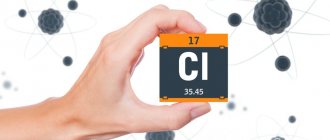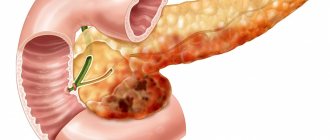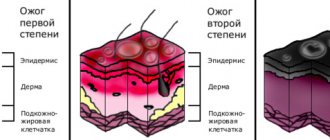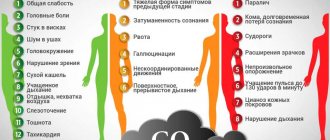- Treatment of hematomas
A head contusion is a fairly common injury, which is a violation of the integrity of soft tissue or bone structures as a result of exposure to external factors. In almost 80% of cases, it does not pose any particular danger, but in 20% of patients, traumatic brain injury leads to severe brain damage and requires immediate medical attention.
Head contusion is one of the most common injuries
Depending on the location, damage to the forehead, occiput, frontal, parietal, temporal lobe, or base of the skull may occur. In some cases, injuries to several areas are observed simultaneously. Depending on the severity, bruises can be mild, severe or moderate. Often the result of trauma is superficial wounds that do not affect brain function.
Causes
The cause of a contusion of the soft tissues of the head can be:
- road traffic accidents . Both the driver himself and a passenger or pedestrian can hurt his head;
- domestic injuries . Often people get injured while doing work around the house or in the yard, as a result of falls from a height of human height, bruises on hard surfaces;
- criminal traumatism . Contusion of the soft tissues of the head can occur when struck with a blunt object or fist;
- childhood traumatism . A child can get injured while playing, riding a bike, a slide or a swing. In infants, the head is the heaviest part of the body and is therefore often damaged when falling. The baby may also be injured during childbirth;
- sports injuries . Bruises of the soft tissues of the head often occur in adults and children when playing sports. Various types of martial arts, cycling, and ski jumping are especially dangerous for injury;
- industrial injuries . A person can get a bruise to the tissues of the head at work if he does not follow safety rules.
Indications for hospitalization
A doctor may refer you for hospitalization if there are the following grounds:
- post-traumatic amnesia;
- prolonged loss of consciousness;
- coma;
- epileptic seizure;
- bleeding;
- disorientation;
- obvious disorders of the nervous system;
- the patient is pregnant (even if she feels normal).
During treatment for TBI, the patient's condition may fluctuate. Periodically, the symptoms intensify and subside. Predictions can only be made after a full course of therapy. Unfortunately, the mortality rate for TBI reaches 25%. The main cause of death is inadequate first aid and reluctance to go to the hospital.
Symptoms
Signs of a soft tissue injury to the head:
| Symptoms | Description |
| Painful sensations | They arise as a result of a blow, as well as a subsequent sharp spasm of blood vessels. In severe cases, headache may accompany the patient during the recovery period |
| Hematoma | Formed at the site of impact. A hematoma (often called a lump) occurs due to hemorrhage due to rupture of large and small capillaries. Blood accumulates in the resulting cavity, and swelling and bruising appear on the skin |
| Other Possible Signs | When the skin is cut, abrasions and wounds occur. If the bruise occurs in the nasal area, bleeding may develop. When the lips are damaged, severe swelling is often observed in this area. Damage to soft tissue in the forehead, eyes and bridge of the nose leads to bruising |
The following symptoms may indicate a concussion:
- short-term loss of consciousness and memory (up to 3–5 minutes);
- moderate headache;
- single vomiting without nausea;
- involuntary eye movement (nystagmus).
First aid
After a head impact, signs of TBI appear quickly. The main thing is to be careful. The most striking symptoms: vomiting, nausea, fainting. It is very important not to get lost, to act confidently and quickly:
- Call the doctors.
- Apply something cold to your head (ice, compress). This will help narrow the blood vessels, minimize the risk of hematomas, hemorrhages, lumps, and prevent or reduce swelling.
- Carefully examine the victim. Sharp pain in the neck may indicate damage to the vertebrae. It is important to fix the position and not change it until the ambulance arrives.
- In case of fainting, bring ammonia to your nose. Wipe with cool water. It is strictly forbidden to hit people on the cheeks. Such an action will increase the consequences of damage.
- Treat wounds. The use of chlorhexidine and hydrogen peroxide is allowed.
- If heavy bleeding begins in the temple area (spouts like a fountain), pinch the vessel with your fingers. After this, apply a bandage with furatsilin or miramistin. After attaching the bandage with a bandage, wrap your head with a bandage.
- If vomiting occurs, place the person on their side. This is necessary for the random flow of vomit so that the victim does not choke. It is advisable to place a clean cloth and change it periodically when it gets dirty.
Having done everything necessary, you need to wait for the doctors. If a person has not lost consciousness and feels more or less normal, you can not call an ambulance, but take him to the hospital yourself. The main thing to remember is that the consequences of TBI can be quite serious. Only a doctor can assess the condition, so a visit to the clinic should not be neglected.
First aid for head injury
It must be remembered that any head injury can be dangerous, so after providing first aid you should consult a doctor. Immediately after a bruise, it is advisable to take a horizontal position.
If the victim loses consciousness (even for a short period), dizziness, vomiting without nausea, confusion or vision problems, you must immediately call an ambulance.
Light superficial injuries (abrasions, cuts) do not require special treatment; primary treatment is sufficient. If the skin is damaged, an antiseptic must be applied to the wound: Hydrogen peroxide, Chlorhexidine, Miramistin.
In some cases, a bandage is applied to the affected area. If the wound is too deep and bleeds heavily, stitches may be necessary. Subcutaneous tense hematomas are opened under local anesthesia.
Peculiarities of manifestation of traumatic brain injuries in children
In babies under one year of age, there is a sharp increase in temperature to 38°C and above. This reaction is associated with:
- wound infection;
- inflammation;
- suffered stress;
- inappropriate use of medications.
The child is not able to clearly describe his feelings, so it is quite difficult to make a diagnosis. There is a risk of underestimating the severity of the injury. Warning signs in this case are:
- pale skin;
- lethargy, drowsiness;
- increased heart rate.
Over time, vomiting, regurgitation, tearfulness, and capricious behavior appear. The baby sleeps restlessly and often gets up at night. If it is SHM, then the symptoms go away within a week.
Please note that infants and the elderly do not experience fainting during SHM.
Treatment at home
Treatment of hematomas
In order to quickly get rid of a hematoma at home, external agents are used, which include heparin, troxerutin, horse chestnut or medicinal leech extract (Lioton, Lyogel, Troxevasin, Sinyak-OFF, Venitan). They are applied to the damaged area up to three times a day.
Heparin-based agents are used to treat hematomas
Drugs from this group improve blood circulation, strengthen the walls of blood vessels, and resolve blood clots. Their use speeds up recovery and shortens the treatment period.
Such ointments and gels are not recommended for use in cases of hypersensitivity to the components, as well as in diseases accompanied by blood clotting disorders. The products should not be applied to damaged skin; they should be used with caution during pregnancy and breastfeeding.
Painkillers and decongestants
If a head injury is accompanied by severe pain, the doctor may recommend taking analgesics: Paracetamol, Analgin, Tempalgin. Drugs based on ibuprofen (Imet, Nurofen, Ibuprom) or nimesulide (Nimid, Nimesil) help cope with pain.
If a bruise is accompanied not only by pain, but also by severe swelling of soft tissues (in case of injuries in the nose or eyes), then the patient’s condition can be alleviated with the help of drugs such as Flamidez or Maxigesic. The composition of the products includes diclofenac potassium, paracetamol and serratiopeptidase.
Drugs in this group have pronounced anti-inflammatory, analgesic, anti-edematous and fibrinolytic effects. The medicine is taken twice a day after meals with a glass of water. Treatment is continued for 5 days. During this period, the patient's condition improves significantly.
Folk remedies
A bump or bruise due to a contusion of the soft tissues of the head can be dealt with using folk remedies:
- recipe No. 1: peel the potatoes and grate them on a fine grater. The pulp is wrapped in gauze and applied to the affected area for half an hour. The procedure is repeated 3–4 times a day;
- Recipe No. 2: starch helps to quickly remove a bruise. The powder is diluted with warm water to the consistency of thick sour cream and applied to a bruise or bump. After the product dries, it is washed off with warm water. The procedure is repeated twice a day until the condition improves;
- recipe No. 3 : to quickly remove a lump, beat off a cabbage leaf and apply it to the hematoma, securing it with a bandage on top. The sheets are changed as necessary. Use this remedy until the lump decreases;
- Recipe No. 4: immediately after a bruise, wash the damaged area with laundry soap and leave it until dry, this will make it possible to prevent the appearance of a bruise. This product should not be used if the skin is damaged;
- recipe No. 5: in order to reduce swelling, you can use a compress with apple cider vinegar. For these purposes, only natural products are used. Vinegar is diluted with water in a ratio of 1: 1, a napkin is moistened in the solution and applied to the damaged area, securing it with a bandage. The compress is left for two hours. The procedure is carried out daily. You should not use apple cider vinegar if your skin is damaged, as it may increase pain.
Diagnosis of TBI
Even if you provided first aid, know how to treat, and have previously encountered similar injuries, do not be arrogant. Examination of the victim by a qualified physician is mandatory. If you don’t want to call an ambulance, take him to the clinic yourself. Just before doing this, make sure that the spine is damaged and the skull bones are not cracked.
The most accurate conclusion can be made using magnetic resonance therapy and computed tomography of the head. The procedures are painless. With their help, you can thoroughly study the structure of the brain, look for the presence of hemorrhages, hematomas, etc.
If it is not possible to do MRI and CT (the clinic does not have machines), diagnostics should include:
- X-ray of the skull.
- Encephalography of the head.
- Examination by an ophthalmologist.
Encephalography will also help detect hemorrhage. In this case, hospitalization cannot be avoided.
If, after an injury, the patient has liquor leaking from the ears or bruises under the eyes in the form of glasses, you should consult a doctor immediately. Self-medication or lack of help, in this case, often leads to death.
You can undergo an MRI or CT scan in Moscow at any time of the day and regardless of the day of the week. You can find a clinic with 24-hour service, close to the patient, using the service: https://msk-mrt.ru/articles/. There are hundreds of medical centers operating in different modes here. Within a few minutes you can find a clinic and make an appointment by phone. Registration through the website allows you to get a discount on the examination.
Consequences of a head injury
In most cases, mild bruises of the soft tissues of the head in the form of bumps and bruises disappear on their own within 7-14 days, without causing negative consequences.
Consequences of a head injury can include headaches and dizziness.
If the injury is serious enough and there is no treatment, the following complications may develop:
- deterioration in performance;
- memory impairment;
- sleep problems (drowsiness during the day or insomnia at night);
- difficulty concentrating;
- frequent dizziness;
- headache;
- weather dependence;
- irritability.
To prevent a bruise of the soft tissues of the head from causing complications, the patient must follow all the doctor’s recommendations during the treatment period. It is important to avoid heavy physical activity and spend less time at the computer.
It is necessary to follow a routine, sleep at least 7 hours a day and walk in the fresh air for a long time. If, despite treatment, the general condition does not improve, you should consult a doctor again.
Classification of TBI by severity
There is a special Glasgow scale. It helps determine the severity of the head injury. Experts conduct tests and evaluate:
- motor reactions;
- speech reactions;
- opening the eyes.
For each test, points are awarded and summed up:
- 14-16 - mild degree;
- 9-13 - average;
- 8 - heavy;
- 3 or less - deep coma.
Regardless of the severity of the injury, it is important to seek help promptly. Timely and adequate therapy reduces the risk of complications and improves the prognosis.









